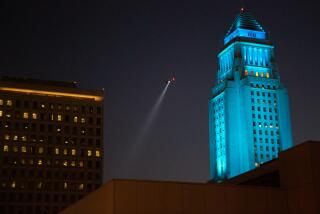LAPD ghost cars: Cops lied about officers on patrol, report finds

Los Angeles police deliberately deceived senior officials by artificially inflating the number of officers on patrol, according to an investigation by the LAPD’s independent watchdog.
In a report released Friday, the inspector general for the Police Commission found evidence that officers in at least five of the department’s 21 patrol divisions were said to be patrolling city streets in cars when, in fact, they were at station desks.
LAPD officials did not immediately respond to a request for comment.
The report’s findings bolstered allegations made by union officials that patrol commanders around the city were using the so-called ghost cars to mask the fact that they did not have enough officers on patrol to meet mandatory staffing levels.
“This has been going on for years,” said veteran officer Mark Cronin, a director in the Police Protective League, which represents rank-and-file cops. “It is more prevalent in some areas, but it’s happening throughout the city.... There is this intentional misperception being put out there that there are more officers on the street than are actually there.”
The practice of manipulating patrol statistics “occurred during multiple shifts at different times of day, involved officers of differing ranks, and was carried out differently depending on who was involved and where they were assigned,” wrote Alex Bustamante, the inspector general, in his report.
The department’s Office of Operations, which oversees patrol deployments, relies on a computer program to analyze various factors and to determine the workload in each division at different times of day. The program calculates how many patrol cars are needed to allow officers to respond to emergency calls within seven minutes -- the department’s long-established standard, Bustamante wrote.
To keep tabs on the deployment levels, department officials require station supervisors to document in a computer database what assignment each officer was given on every shift. And twice every day — at noon and 10 p.m.— a snapshot of deployment statistics for each division and the department’s four bureaus and sent by email to senior officials.
Staff in the Office of Operations closely monitor whether the required patrol levels are met and the captains that run each division are held accountable if they fall short, Bustamante wrote.
Bustamante opened his investigation after hearing reports from officers of how the ghost car scheme was used to make it appear as if divisions were meeting the deployment requirements.
The inquiry focused on deployment in two divisions, which were not named in the report, during March last year. It did not specify how often patrol figures were inflated but documented several examples of how ghost cars were used.
In one typical case, an officer assigned to assist detectives logged in to a patrol car’s computer but remained at the police station for the entire shift working on investigations, Bustamante found. To make sure dispatchers did not try to send the officer to a help call, the officer radioed in to the dispatch center to make it appear he or she was already on a call, according to the report.
The report did not identify who in the each of the divisions chain of command ordered the numbers to be fabricated.
Cronin described an “intense pressure” that captains feel to meet the staffing requirements and to not run afoul of Asst. Chief Earl Paysinger, who runs the Office of Operations, and other top officials. That pressure, Cronin said, “trickles down” to the sergeants and lieutenants who handle patrol deployments.
Bustamante noted in his report that top department officials responded swiftly when he alerted them to his findings.
In an email, Paysinger instructed his senior staff to “be very clear that employing this type of feigned deployment practice is NOT permissible. If such a strategy is currently being utilized on any watch or in a specialized unit in your bureau, you shall cause it to be terminated immediately.”
And in a sign that they suspect the problem was not limited to the divisions Bustamante investigated, department officials also agreed to conduct unannounced audits in every division over the next two years, according to the report.
Twitter: @joelrubin
More to Read
Start your day right
Sign up for Essential California for news, features and recommendations from the L.A. Times and beyond in your inbox six days a week.
You may occasionally receive promotional content from the Los Angeles Times.







